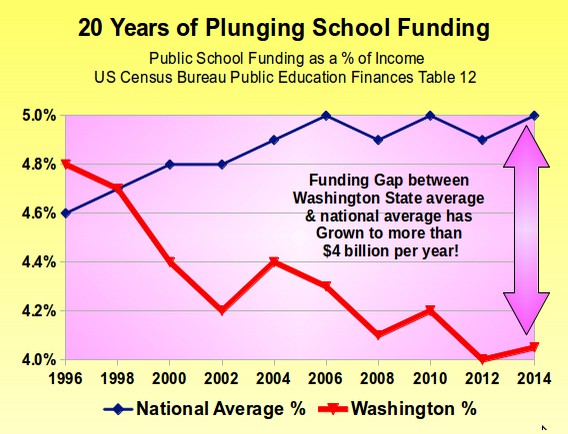
Graphic from Washington Tax Fairness Coalition, click to embiggen.
This week is the real start of the new year.
Parents take their five-year-olds to their first day of kindergarten, kids return to new grades and new expectations, high schools gear up for football and cross country and soccer, the weather turns colder and wetter, the days are shorter, and our teachers renew their calling and mission to educate the children of our state.
One out of every 7 people in our state is a public K-12 student. In Snohomish County, over 130,000 kids are in the public school system, ranging from 45 in Index to 20,000 each in the Everett, Edmonds, and Northshore school districts.
Just as democracy is not perfect, public schools, the foundation of our democracy, are not perfect either. Our state government has consistently underfunded public education, in violation of its paramount constitutional duty — and that’s not me speaking, but our state Supreme Court.
It would take $3.5 billion a year more at the minimum to appropriately reduce class size, pay our teachers better, and offer more courses and choices and opportunities for students. That may sound like a lot of money, and it is, but it is also only about $17 a day more per student. The Legislature wants us to believe that they are fully funding education, but only by ignoring the $100,000 a day fine that the state Supreme Court has laid on the Legislature for its failure to fund education, and by amending and delaying the initiative to lower class sizes that the people approved just 10 months ago. That’s hardly full funding, that’s simply a mischievous and misleading narrative.
One huge barrier to funding public education is the opposition of the very wealthy as a class to an income tax that they would have to pay. (This doesn’t hold true for some wealthy individuals, who support income taxes and full funding for education.) A tactic to distract the conversation from full funding for all students to targeted funding for a very small percentage of students was the initiative for charter schools in 2012. That was bankrolled by billionaires to the tune of $11 million. It was passed with 50.69 percent of the vote. As it happens, it was an initiative that violates our state constitution, and has now been thrown out by the state Supreme Court.
Public schools aren’t perfect. In a world where we expect students to progress beyond high school into college, the data is discouraging. In the Arlington School District, 51 percent of high school graduates went onto college or community college in 2013. That means that nearly half didn’t. In 2008, 60 percent went onto college. In Everett 64 percent of graduates in 2013 went on to college. Fully one third did not. In Stanwood, 55 percent of graduates went to college in 2014, in Monroe 53 percent, in Lake Stevens 60 percent, in Marysville 51 percent.
We are obviously leaving a lot of kids behind. And yet, Initiative 1351, which would have reduced class sizes in high school as well as elementary school, was left completely unfunded by the Legislature.
Do small classes only make sense for elementary kids? Perhaps we can take a lesson from the private school where the elite send their kids — Lakeside School in Seattle. The average class size for this middle school and high school: 16. Average class size in our public high schools: 30.
Here is a lesson: If you want to neglect students, increase drop-outs, and have high school be the final stop in education, then increase class size. On the other hand, if you want students to know that teachers know who they are, care about them, expect more of them, challenge them, discipline them, and will help them succeed, then look to Lakeside and decrease class sizes. You can’t hide in a room of 15 kids.
One problem: This costs money.
Our Legislature has shrugged and put this off for too long. So we start this new school year with optimism and hope, and continual underfunding. The legislature says it supports K-12 education. But as citizens, and for the sake of our kids and our future, we should say: “Show me the money.”
More To Read
May 2, 2024
Baby Bonds: A Step Toward Racial and Economic Equity
The Washington Future Fund would bring this innovative, anti-racist policy to the Evergreen State
May 1, 2024
Laws Targeting LGBTQ Youth Aren’t Just Bad for Kids – They’re Bad For The Economy
The harm done by anti-LGBTQ laws expands so much further than queer children and teens
April 26, 2024
What is WA Cares and Why Does It Matter for Washingtonians?
We need to defend this important policy from billionaires looking to save a buck
